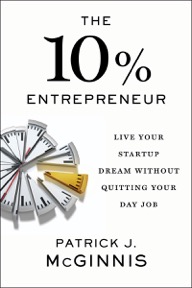
 By Patrick McGinnis
By Patrick McGinnis
 Interview by Stephen Camilli
Interview by Stephen Camilli
Editors’ note: This month, Stephen Camilli, president of ACTEX Learning, and vice-chair of the E&I Section, sat down with an old friend, Patrick McGinnis, author of The 10% Entrepreneur, to glean some of McGinnis’ insights and understand how they can apply specifically to actuaries. McGinnis will be offering a webinar with our section on Sept. 21 of this year.
Patrick is a venture capitalist and private equity investor who founded Dirigo Advisors, after a decade on Wall Street, to provide strategic advice to investors, entrepreneurs, and fast-growing businesses. In this capacity, he has worked in a range of settings, from building startups from the ground up in Silicon Valley to acting as an expert consultant to the World Bank in Latin America, Africa, and the Middle East.
As a 10 percent entrepreneur, he has built a diverse portfolio of investments outside of his day job including ipsy, the world’s largest online beauty community; Bluesmart, the inventor of the world’s first smart, connected carry-on suitcase; and Afiniti, a big data company that is reinventing the call-center industry. An avid traveler, writer and speaker, Patrick has visited more than 70 countries and is fluent in Spanish, Portuguese, and French.
He is the author of The 10% Entrepreneur, published by Penguin Portfolio. He also writes for Fortune, Business Insider, Huffington Post, Boston Magazine, and Forbes. Patrick is a graduate of Harvard Business School and Georgetown University and lives in New York City.
IC: As you know, actuaries as a group seek to limit risks and seek optimized outcomes. Briefly describe what a 10% entrepreneur is, and how an actuary might put it into practice.
McGinnis: We live in a time when entrepreneurship is changing industries and careers as never before. At the same time, the falling cost of technology and the growing flexibility in how we work presents an opportunity—you don’t have to think of entrepreneurship as an all-or-nothing proposition. Rather, you can think of entrepreneurship as an enhancement to the rest of your career, that can be tailored to your life in a way that offers you diversification, upside potential, and new experiences.
When you are a 10 percent entrepreneur, you seek to invest at least 10 percent of your time and, if possible, 10 percent of your capital into new opportunities. By leveraging your base of experience and your network, you choose opportunities that play to your strengths and that are complementary to your career and your interests. In doing so, you achieve more than just diversification. You also learn what it means to be an entrepreneur so that you can bring that thinking back into the rest of your career in order to achieve more and position yourself for greater success in a changing world.
Actuaries operate in an industry—insurance—where technology is rapidly changing the rules of the game. In fact, given the sheer size of the insurance industry, billions of dollars are being invested annually to disrupt traditional models and to harness the power of data within the space. As a result, actuaries can leverage their very specialized skills to invest in, advise, or even start new companies—on the side—that allow them to partake in the change that is going to transform the industry going forward. Rather than fearing change, you can instead benefit from it and also potentially drive it.
So many great success stories are of entrepreneurs who do leave everything. How did you have the idea for the 10% entrepreneur?
There is a whole mythology out there, something I like to call Entrepreneurship, Inc., that glamorizes full-time entrepreneurship without showing the real risks, from failure to personal financial distress to the real psychological costs of leaving a stable and prestigious job for very unsure pastures. Anyone who has ever left a great job to do a startup that no one has ever heard of knows what that feels like – people’s eyes glaze over when you tell them what you do. The statistics tell us that most new ventures fail and while everyone likes to lionize the entrepreneurs who ran up his or her credit cards before becoming a massive success, no one talks about the other entrepreneur who ran up his credit cards and then never paid them off.
At the same time, entrepreneurship is going to transform most industries, so it must not be ignored. Rather than choosing between the stability of a day job and the excitement and upside of entrepreneurship, I asked myself – Is there another way? That’s how I came up with the idea of the 10% Entrepreneur. Investing 10% of your time and your capital felt meaningful, but doable. It’s a risk-mitigated way to invest, learn, and take part in entrepreneurial ventures without giving up all of the benefits of having a stable career. Later, I learned that according to the Angel Capital Association, the average angel investor allocates approximately 10% of his or her portfolio towards those types of opportunities.
Becoming a 10% career requires some planning. You need to assess your resources – in terms of time, capital, and intellectual capital or experience – and then determine how to best leverage them to participate in new ventures. Then, beyond that, it’s really a question of mindset. There are lots of reasons NOT to become a 10% Entrepreneur: you’re too busy, you’re uncertain about taking on risks, or you’re not sure you know how to begin, but once you decide to move forward and actually get going, you’ll see that it’s a very practical and pragmatic strategy.
Are there particular risks people need to watch out for along the way?
First of all, always respect your employer and your day job and make sure you follow the rules set down by your employer. Never use work resources for your own project - don't make photocopies with the work photocopiers or use work email for your own endeavors. It is your day job that allows you to build a 10%, so always respect that day job.
Second, recognize that you have clear skills, but there are areas where you’re going to need to learn and develop new capabilities. That’s how 10% Entrepreneurs approach the world – they seek opportunities to learn and expand in ways that open new opportunities.
Are there any statistics out there about the pros and cons of being an entrepreneur part-time vs. full-time?
A combination of statistics and real options theory shows that part-time entrepreneurship increases your chance of success. The study Should I Quit My Day Job – A Hybrid Path to Entrepreneurship by Raffie Feng out of the University of Wisconsin-Madison proved that entrepreneurs who start their business on a part-time basis are 33% less likely to abandon that businesses versus those who enter directly from full-time employment. It makes sense. Waiting to see if a venture actually is gaining tradition before jumping in full time – in the parlance of real options theory, waiting to see if an option is in the money, means that you are more likely to make a good investment. It’s also worth noting that pursuing a project on the side is far more sustainable than jumping in full-time. The minute you go full-time you have a financial pressure – you must either raise capital or invest your own money – and you only have so much runway before you run out of cash. If you’re still working and receiving a pay check, that pressure no longer exists, so you can take more time to test your idea and validate it.
What specific projects would you envision as ideal for actuaries?
In 2015, the FinTech industry raised over US$13 billion in capital. All of those companies need experts – such as actuaries – who can contribute either as advisors (investing their time in exchange for “sweat” equity), investors, or co-founders. The key to finding projects for your 10% is identifying your strengths and then matching to projects that excite you. When you have a definable skills – as you see with actuaries – it’s rather simple to target particular industries and then get engaged. Of course, you don’t have to stick to FinTech. You can also find ways to invest in projects you love that might not be specifically FinTech related, but that allow you to leverage your skills, experience, and areas of interest.
You’ll be offering a webinar with our section on September 21st. Can you tell us why we should attend, and what we might get out of this webinar?
No matter what industry you work in and often no matter your role, it’s now critical to think like an entrepreneur. Whether you’re a partner at Goldman Sachs, a manager at a mid-sized manufacturing company, or an actuary, you will need to apply the creativity and the nimble mindset employed by entrepreneurs to take advantage of the opportunities around you and to remain relevant. Still, at the same time, it’s difficult to learn how to think like an entrepreneur without actually doing the work of an entrepreneur. The solution to this challenge is to use 10% Entrepreneurship to achieve exactly that outcome, learning to be an entrepreneurial in a way that mitigates risk while giving you a whole new set of skills and a fresh mindset.
Stephen Camilli, FSA, is the president of ACTEX Learning. He can be reached at Stephen@actexmadriver.com.